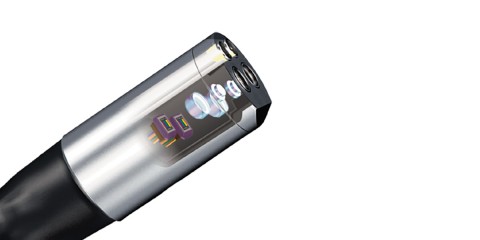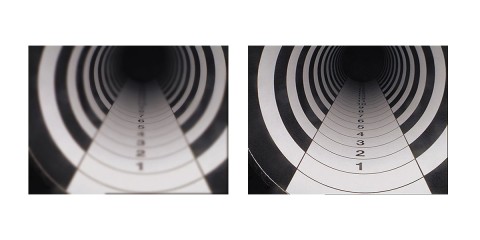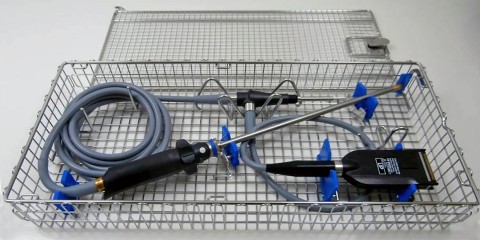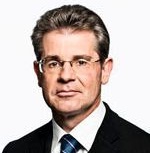Hamburg, 01/04/2018 | Story | Medical Systems ENDOEYE: Entering a Third Decade of Precision and Innovation
For more than 20 years, ENDOEYE has been known for providing users with optimum image quality and for being extremely easy to operate. Reason enough to take a look back over two decades of innovation and precision. In doing so, we spoke to colleagues who have been involved from the outset.
It all began with an idea
At the start of the 1990s, the idea of integrating a camera including electronics and a video chip into a rigid endoscope and providing physicians with an all-in-one solution seemed a no-brainer, especially as similar features had already been seen on flexible endoscopes. Nevertheless, it required the conviction of one man and the commitment of a small team to finally turn this idea into a reality and make it a success.
“Back then, as the appointed team, we were able to focus all of our efforts solely on this single product.”
The driving force behind the project at OSTE (then still Olympus Winter & Ibe) was company boss Hans-Joachim Winter himself, who believed in the idea and granted a team led by physicist Dr. Mathias Kraas the freedom it required to develop the visionary idea into a finished product. Alongside Mathias Kraas, the initial team consisted of Timo Wenzel, Andreas Mückner, and Olaf Girke.
“Back then, as the appointed team, we were able to focus all of our efforts solely on this single product”, says Andreas Mückner, SI R&D Hardware Department Manager. These days, that would be virtually inconceivable given how teams of developers are required to work on several developments simultaneously. “However, in recent years we have been trying to reinstall that kind of creative freedom in our innovation management”, confirms Dr. Kraas, now Director R&D at OSTE.
The team began to develop the first rigid video endoscope back in 1993 and, despite all the freedom they were granted, still encountered several obstacles. The project was not without its skeptics who said that users would find having to pay for an individual camera head with each endoscope too expensive. The video chips were also still too large which meant that the video endoscope had to be manufactured with a diameter of 11 mm instead of the standard 10 mm.
The success exceeded all expectations
Nevertheless, all the obstacles were overcome and sales of the finished product began in November 1996, with the first unit being purchased by a Norwegian customer. Dr. Kraas said “It was a brilliant moment in time for all of us. When I took over the project, I was fresh out of university and had no real idea about the market. The economic success of the product that we had spent years working on was in no way ever guaranteed.”
However, it exceeded even the high expectations of the new idea’s backers. They had expected to make 50 sales in the first year at Olympus, but in fact, by the end of the first year, the order books contained more than 350 sales. The real breakthrough in customers’ eyes was the introduction of the “Plug and Play” principle, which significantly simplified handling and was extremely popular with users. Timo Wenzel, Repair Engineering Project Manager: “From a technical point of view we were actually forced to build the video endoscope like that. However, we hadn’t expected that this would actually meet the needs of the market the way it did.”
From then on, the rigid video endoscope, later called ENDOEYE, became an enduring success story. Dr. Kraas said “It is a real unique selling point for us, even to this day. None of our competitors are able to develop, let alone produce, such a complex device. What’s more, the ENDOEYE is also autoclavable.”
Product development milestones
The success has also largely been due to the systematic research work invested in the ENDOEYE products following the initial positive developments, which has led to a whole host of pioneering innovative products.
By 1999, the team managed to manufacture the A48 generation of the video endoscope with a standard 10 mm diameter. Just one year later, thanks to licensed technology, mechanical image rotation was introduced, providing physicians with a much broader field of vision.
The A50 generation, launched in 2002, was the first ENDOEYE endoscope available with a diameter of just 5 mm. The introduction of the first ENDOEYE with HD image quality in 2006, developed by a team under the leadership of Dr. Harald Hanke, constituted a “quantum leap in terms of image quality” (as Dr. Kraas puts it).
The launch this year of the ENDOEYE 3D, the first and as yet only rigid 3D endoscope with a 30° viewing angle and integrated image rotation, and which has already received rave reviews from physicians, constitutes a comparable leap forward in terms of development.
Since 2002, all the development and manufacturing work has been carried out at OSTE in Jenfeld. Previously, the optical devices were supplied from Japan with final assembly being carried out at OSTE. In 2003, there were 30 employees working in Production, a figure which has now increased to 90 with plans for that number to rise to 100.
In 2017, the ENDOEYE range now consists of 30 different products used in an extremely wide variety of applications in urology, gynecology, general surgery, and thoracic surgery. Over 2,500 units are now produced every year.
Pushing the boundaries of what is technically feasible
Achieving ever higher resolutions with ever smaller diameters is, in a nutshell, the guiding principle behind the continuous technical development of the ENDOEYE. As such, the developers find themselves fighting a constant battle against physical limitations. “We are really pushing the boundaries of what is technically possible”, says Timo Wenzel, describing the challenges.
Furthermore, autoclavability is an absolute must for video endoscopes. This means that the technical components integrated into the endoscope need to be able to withstand temperatures of up to 134°C during the cleaning process. The video chips are only able to cope with temperatures of around 70°C and therefore require appropriate protection. “We have invested vast sums and carried out several tests in this specific area. However, the experience that we have gained from this also benefits other products”, says Dr. Kraas.
“We continue to refer to ourselves as a craft producer and are very proud of that.”
The trend to “miniaturize” technology also involves particular challenges in terms of manufacturing. “We are pioneering technology to a certain extent here”, says Stephan Wolf, Section Manager OPS Manufacturing, who has also been involved in the production of the video endoscopes for 14 years, “for example, during soldering, we work in dimensions that people thought would not be possible.”
This, of course, also has knock-on effects in terms of the selection process for new manufacturing employees. For a long time now, candidates’ training has not been the only thing taken into consideration, but explicitly also their affinity for particularly small structures. As such, alongside precision engineers, it’s not unusual for successful candidates to include individuals with experience in other backgrounds such as carpet makers and confectioners.
Even though the requirements of the new 3D ENDOEYE, in terms of the precision of the orientation of the optics, are so high that they can only be processed via computer control by means of a mechanism specially developed by one of the Fraunhofer Institutes, manual craftsmanship remains a key factor in the production of ENDOEYE products. “We continue to refer to ourselves as a craft producer and are very proud of that”, says Stephan Wolf.
Times are changing: large teams are needed today for the development of new product generations. The picture shows the development team for the ENDOEYE 3D
Outlook
The video endoscope production process is becoming more and more complicated, the technology ever smaller and more refined, and even the handling of the high-tech devices requires a certain level of sensitivity. Video endoscopes are relatively maintenance-intensive. On average, the devices need to be serviced once a year, and the ENDOEYE has unfortunately also not been without its serious setbacks. Last year, 5,000 ENDOEYE endoscopes of two product types had to be recalled as a precaution because overheating of the distal end of the endoscope could not be ruled out. Luckily, the required deactivation of the defective function could be carried out on site, which meant that downtime for customers could be minimized.
As a result of this recall and the required follow-up measures, production of the new ENDOEYE 3D came to a standstill. However, gradually OSTE is managing to get to grips even with this problem. Andreas Noe, General Manager, Business Unit General Surgery at OSTE said “The output of the ENDOEYE 3D is definitely still not at the level that we would like. However, I think that the improvement measures that have been implemented in the manufacturing process are resulting in considerably higher output quantities and that we are making another big leap forward.”
Belief in the success of ENDOEYE remains, in any case, steadfast. In the next five years, EUR 18 million is expected to be invested in the development of future product generations.
Dr. Kraas is also optimistic: “We have some very exciting developments in the pipeline. The second 3D generation and the fact that the new Olympus video platform and the 3D ENDOEYE support the use of fluorescent substances (ICG) with suitable IR laparoscopes will provide our customers with new diagnosis and treatment options. I’m already looking forward to it all.”













